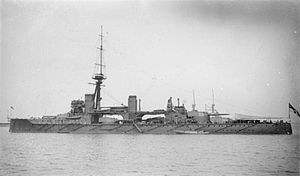
Back Колосус (линеен кораб, 1910) Bulgarian Colossus (Schiff, 1911) German HMS Colossus (1911) Spanish اچاماس کلوزئوس (۱۹۱۰) FA HMS Colossus (1910) Finnish אה"מ קולוסוס (1910) HE HMS Colossus (1910) Italian コロッサス (戦艦) Japanese HMS «Colossus» (1910) NB HMS Colossus (1910) Portuguese
 Colossus at anchor, shortly after completion, 1911
| |
| History | |
|---|---|
| Name | Colossus |
| Namesake | Colossus of Rhodes |
| Ordered | 1 June 1909 |
| Builder | Scotts, Greenock |
| Laid down | 8 July 1909 |
| Launched | 9 April 1910 |
| Completed | July 1911 |
| Commissioned | 8 August 1911 |
| Reclassified | As a training ship, 1921 |
| Stricken | 1923 |
| Fate | Sold for scrap, July 1928 |
| General characteristics | |
| Class and type | Colossus-class dreadnought battleship |
| Displacement | 20,030 long tons (20,350 t) (normal) |
| Length | 545 ft 9 in (166.3 m) (o/a) |
| Beam | 86 ft 8 in (26.4 m) |
| Draught | 27 ft (8.2 m) |
| Installed power |
|
| Propulsion | 4 × shafts; 2 × steam turbine sets |
| Speed | 21 knots (39 km/h; 24 mph) |
| Range | 6,680 nmi (12,370 km; 7,690 mi) at 10 knots (19 km/h; 12 mph) |
| Complement | 751 |
| Armament |
|
| Armour | |
HMS Colossus was the lead ship of her class of two dreadnought battleships built for the Royal Navy at the end of the first decade of the 20th century. She spent her whole career assigned to the Home and Grand Fleets, often serving as a flagship. Aside from participating in the Battle of Jutland in May 1916 and the inconclusive action of 19 August, her service during World War I generally consisted of routine patrols and training in the North Sea. Colossus was the only dreadnought from the main body of the Grand Fleet to be hit during the Battle of Jutland, although she suffered only minor damage.[1] The ship was deemed obsolete after the war and was reduced to reserve and then became a training ship. Colossus was hulked in 1923 and sold for scrap in 1928.